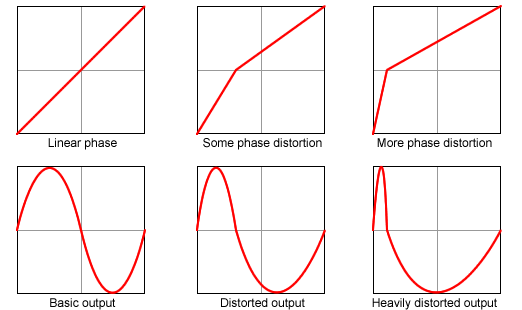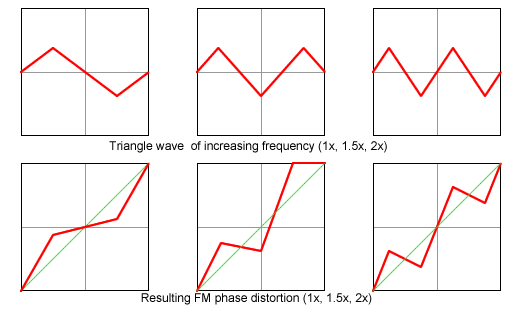I heard about this and could find little about it, so I started to investigate. Phase Distortion is one of those forgotten synthesis techniques that someone once built a few instruments with, and then abandoned. In the case of PD, Casio were unlikely synth pioneers to start with, and after a brief flirtation they gave up on the professional market and went back to making home keyboards.
The real question is whether, if they’d stuck at it, phase distortion could ever be any good.
So how does phase distortion synthesis work?
Firstly, you need to understand the principles of a Direct Digital Synthesis (DDS) Oscillator. This is a common type of digital oscillator. It uses a large counter called the ‘Phase Accumulator’. The counter is incremented by a set amount (the Frequency Increment) every sample. The output from the counter is used as an index into a waveform lookup table.

Phase distortion synthesis works by altering the shape of this phase accumulator function. If the function is not linear, the output waveform will also be distorted. This will introduce harmonic changes into the sound. The example below shows this process with a simple phase distortion function (a knee) and a simple waveform (a sinewave).

This same phase distortion function can produce a variable pulsewidth output (PWM) when given a squarewave table, or turn a triangle wave into a ramp wave. Since it is both simple and versatile, I used it for the wave distortion on my VCLFO.
What’s the difference between PD and FM/PM synthesis?
The short answer is “Not a lot”. Phase distortion synthesis is essentially a special case of the more general phase modulation synthesis, as used by Yamaha in their ‘FM’ synths. That these two are equivalent is shown in the diagram below, where a phase distortion function can be seen as the addition of a triangle wave to the base phase accumulator.

PD is more limited than FM because PD always uses modulators that are at the same frequency as the carrier, or sometimes at a simple multiple of its frequency. Increasing the frequency of the triangle wave (as would be possible on an FM synth) produces a complex effect on the phase distortion.

The interesting bit of PD synthesis compared to Yamaha’s FM is that the waveshape of the modulator is not just a simple sine wave, and furthermore can be modified. The sine-to-ramp PD waveform on the Casio CZ is the same as applying a variable ramp-down/triangle/ramp-up waveform as a modulator to a carrier. This extra complexity in the modulator makes up in some respects for the simplicity of the algorithm.
Hi there, how about resonant waveforms ?
The resonant waveforms aren’t actually produced using the phase distortion technique, which is why they’re not mentioned here. How they are generated is quite interesting though – it’s a technique known as “windowed synchronisation” (described here: http://www.carbon111.com/formant_window.html).
It’s better described with plenty of nice diagrams, so I won’t try in a comment. Perhaps I should do an article on it one time.
Hi, i have the phase distortion waveforms and the resonant waveforms working,
only i dont understand how to make the square wave, and the double sine.
Its easy to make saw out of the basic pulse wave by having phase offset to a quarter of the lookuptable size,
so i guess the pulse square is in between, made with one eighth phase offset.
Can someone give me a clue about how the Square waveform and/or double sine is generated ?
greetins
The best source of detailed information I know is the “CZ Spelunking” pages:
http://www.kasploosh.com/projects/CZ/
Aside from this, you could have a look for the original Casio CZ patent – I seem to remember there’s some useful diagrams in there.
HTH,
Tom
Hi Tom – can you put this more in to a context of VirtualCZ synth (so one can than use it on Bazille)?
There is no Direct Digital Synthesis (DDS) mention in VirtualCZ, CasioCZ (I was skipping HW parts so maybe I missed it here) or Bazille manual, but it looks like it is represented by DCW (Digital control wave – in Bazille it is amount of PD hook up on envelope). I also did not find any vst synth using this DDS technique (probably because as you mentioned the struggle with aliasing – crossing Nyquist freq).
Then it is not clear to me, how can I set up Incrementing Phase – it looks like you have only option to choose from which waveform you wanna morph from – usually sin wave. All math with angle phase is probably processed without option to touch it.
Maybe I get it wrong – but from electronic music production, it looks like what you say here one can put aside same as putting Playboy back to drawer while going on rande-vous ….. and deal with what you got…
Nother helpful comparison would be Zebra/ Spire/ Serum vs VirtualCZ – is there a harmonic content difference while going from f. e. sin to square on VirtualCZ or while set up this to waveform morph in Zebra, Serum, Spire etc.
I ve actually forget – Blue II probably has PD phase angle drawing option – but since there are no tool for editing …